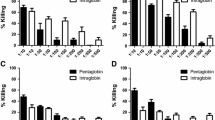Summary
Monoclonal antibodies have obvious diagnostic and therapeutic applications in infectious diseases. The technology for producing these highly specific reagents is readily available and we have produced monoclonal antibodies against the core glycolipid (endotoxin) region of gram-negative bacilli and the O-antigens ofPseudomonas aeruginosa. These antibodies are protective by different mechanisms and more than one antibody against a bacterium may give enhanced protection. Use of antibodies plus antimicrobial therapy may yield optimal results.
Zusammenfassung
Die Bedeutung monoklonaler Antikörper für die Diagnostik und Behandlung von Infektionskrankheiten ist offenkundig. Für die Herstellung dieser hochspezifischen Reagentien stehen Technologien zur Verfügung; wir haben monoklonale Antikörper gegen die Glykolipid-Core-Region (Endotoxin) von gramnegativen Bakterien und gegen O-Antigene vonPseudomonas aeruginosa hergestellt. Diese Antikörper können über verschiedene Mechanismen schützend wirken, und die protektive Wirkung kann erhöht sein, wenn mehr als ein Antikörper gegen ein Bakterium vorhanden ist. Optimale Ergebnisse sind von einer Kombination von Antikörpern mit antimikrobieller Therapie zu erwarten.
Similar content being viewed by others
Literature
Kohler, G., Milstein, C. Continuous cultures of fused cells secreting antibody of predefined specificity. Nature (London) 256 (1975) 495–497.
Galfre, G., Milstein, C. Preparation of monoclonal antibodies: Strategies and procedures: In: Methods in enzymology. Academic Press, London 1981, pp. 3–46.
Kennet, R. H., McKearn, T. J., Bechtol, K. B. (eds.): Monoclonal antibodies. Plenum Press, New York 1980.
Cleveland, W. L., Wood, I., Erlanger, B. F. Routine large scale production of monoclonal antibodies in a protein free culture medium. J. Immunol. Methods 56 (1983) 221–234.
Ehrlich, P. H., Moyle, W. R. Cooperative immunoassays with mixed monoclonal antibodies. Science 221 (1983) 279–281.
Gigliotti, F., Insel, R. A. Protective human hybridoma antibody to tetanus toxin. J. Clin. Invest. 70 (1982) 1306–1309.
Young, L. S., Alam, S., Gascon, R.: Monoclonal antibody directed against the core glycolipid of enterobacterial endotoxin. Clin. Res. 30 (1982) 522 A.
Kirkland, T. N., Ziegler, E. J. An immunoprotective monoclonal antibody to lipopolysaccharide. J. Immunol. 132 (1984) 2590–2592.
Robertson, S. M., Frisch, C. F., Gulig, P. A., Kettmann, J. R., Johnston, K. H., Hansen, E. J. Monoclonal antibodies directed against a cell surface exposed outer membrane protein ofHaemophilus influenzae Type b. Infect. Immun. 36 (1982) 80–88.
Hunter, K. W., Jr., Fischer, G. W., Hemminy, V. G., Wilson, S. R., Hartzman, R. J., Woody, J. N. Antibacterial antibody of a human monoclonal antibody toHaemophilus influenzae Type b capsular polysaccharide. Lancet II (1982) 798–799.
Coates, A. R. M., Hewitt, J., Allen, B. W., Ivanizi, J., Mitchison, D. A. Antigenic diversity ofMycobacterium tuberculosis andMycobacterium bovis detected by means of monoclonal antibodies. Lancet II (1981) 167–169.
Tam, M. R., Buchanan, T. M., Sanstrom, E. G., Holmes, K. K., Knapp, J. S., Siadek, A. W., Nowinski, R. C. Serological classification ofNeisseria gonorrhoeae with monoclonal antibodies. Infect. Immun. 36 (1982) 1042–1053.
Moreno, C., Hewitt, J., Hastings, K., Brown, D. Immunologic properties of monclonal antibodies specific for meningococcal polysaccharides. J. Gen. Microbiol. 129 (1983) 2451–2456.
Hancock, R. E. W., Wieczorek, A. A., Mutharia, L. M., Poole, K. Monoclonal antibodies againstPseudomonas aeruginosa outer membrane antigens. Infect. Immun. 37 (1982) 166–171.
Young, L. S.: Functional activity of monoclonal antibodies against lipopolysaccharide antigens of gram-negative bacilli. Clin. Res. 32 (1984) 518 A.
Harris, M. C., Douglas, S. D., Kolski, G. G., Polin, R. A. Functional properties of anti-Group B streptococcal antibodies. Clin. Immunol. Immunopathol. 24 (1982) 342–349.
Egan, M. L., Pritchard, D. G., Dillon, H. D., Jr., Gray, B. M. Protection of mice from experimental infection with Type III Group B streptococcus using monoclonal antibodies. J. Exp. Med. 158 (1983) 1006–1011.
Robb, M., Nichols, J. C., Whoriskey, S. K., Murphy, J. R. Isolation of hybridoma cell lines and characterization of monoclonal antibodies against cholera enterotoxin and its subunits. Infect. Immun. 38 (1982) 267–272.
Young, L. S. Gram-negative sepsis. In:Mandell, G., Douglas, J. G., Bennet, J. E. (eds.): Principles and practice of infectious diseases. John Wiley and Sons, New York 1979, pp. 571–608.
Young, L. S., Stevens, P., Ingram, J. Functional role of antibody against “core” glycolipid ofEnterobacteriaceae. J. Clin. Invest. 56 (1975) 850–861.
Greisman, S. E., Dubuy, J. B., Woodward, C. L. Experimental gram-negative bacterial sepsis. Reevaluation of the ability of rough mutant antisera to protect mice. Proc. Soc. Exp. Biol. Med. 158 (1978) 482–490.
Rowe, S. N., Meadow, P. M. Structure of the core oligosaccharide from the lipopolysaccharide ofPseudomonas aeruginosa PACIR and its defective mutants. Eur. J. Biochem. 132 (1983) 329–337.
Young, L. S., Armstrong, D. Human immunity ofPseudomonas aeruginosa. 1.In vitro interaction of bacteria, polymorphonuclear leukocytes, and serum factors. J. Infect. Dis. 126 (1972) 257–276.
Levy, R., Miller, R. A. Tumor therapy with monoclonal antibodies. Fed. Proc. 42 (1983) 2650–2656.
Sears, H. F., Atkinson, B., Matis, J., Ernst, C., Herlyn, D., Steplewski, Z., Hayry, P., Koprowski, H. Phase I clinical trial of monoclonal antibody in treatment of gastrointestinal tumor. Lancet 1 (1982) 762–764.
Olsson, L., Kronstrom, H., Cambon-de Mouzon, A., Honsik, C., Brodin, T., Jakobsen, B. Antibody producing human-human hybridomas I. Technical aspects. J. Immunol. Methods 61 (1983) 17–32.
Kozbor, D., Lagarde, A. E., Roder, J. C. Human hybridomas constructed with antigen specific Epstein Barr virus transformed cell lines. Proc. Natl. Acad. Sci. USA 79 (1983) 6651–6656.
Author information
Authors and Affiliations
Rights and permissions
About this article
Cite this article
Young, L.S. Monoclonal antibodies: Technology and application to gram-negative infections. Infection 13 (Suppl 2), S224–S229 (1985). https://doi.org/10.1007/BF01644435
Issue Date:
DOI: https://doi.org/10.1007/BF01644435




